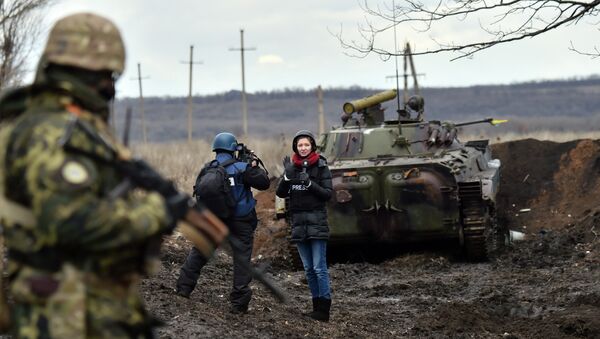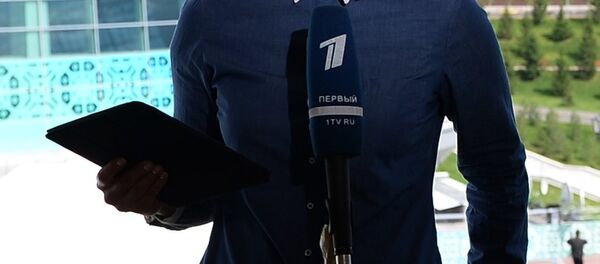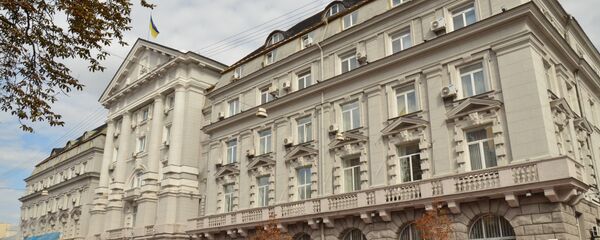MOSCOW (Sputnik) – Below is the list of other incidents with Russian reporters that took place between 2014 and 2017 in Ukraine starting from the most recent ones.
2017
On Wednesday, the Rossiya 24 television channel crew came under fire by Ukrainian military outside Donetsk as it was filming a story about observing the "school truce." No one was hurt.
On August 15, Ukraine expelled Tamara Nersesyan, a Russian reporter and a special VGTRK correspondent.
On July 26, it transpired that a Russian reporter, an employee of Rossiya 1 and Rossiya 24 television channels, Maria Knyazeva, was expelled from Ukraine and denied entry to that country for three years. According to the SBU, Knyazeva led "subversive activities under the pseudonym Saushkina."
On May 7, the Komsomolskaya Pravda newspaper reported that its two reporters Maria Remizova and Elena Boduen, who were properly accredited for the Eurovision song contest, were denied entry to Ukraine. They were taken off the train by Ukrainian border guards at the Konotop checkpoint.
On May 6, Director of MIA Rossiya Segodnya’s Joint Photo Information Directorate Alexander Shtol said that the agency’s photo correspondent Ramil Sitdikov, who was properly accredited for Eurovision, was denied entry to Ukraine. He was issued an official entry denial letter saying he was denied entry "due to an unconfirmed reason for the visit."
On January 31, a cameraman from the Life television channel was wounded in the leg during shelling of the Kievsky district of Donetsk.
On January 29, the crew of the NTV television channel found itself in the shelling zone in the town of Makiivka. The incident took place during recording of interviews with civilians in Makiivka's districts, which came under fire the day before. No one was injured.
2016
On December 19, in Kiev, about 20 people broke into RIA Novosti office demanding to stop a video conference with Ukrainian cities, which was held as part of the Ukrainian Compatriots Congress in Russia. Aggressive young people shouted out anti-Russian slogans. The reporters remained in the office and called in the security and the police. After their arrival, the radical protesters left the building.
On December 12, reporters from several Russian TV channels and news agencies working in the village of Sakhanka, came under machine gun fire. No one was hurt.
On May 17, the NTV television channel film crew came under fire in the Donetsk region. Following a meeting with the Organization for Security and Co-operation in Europe (OSCE) in Dokuchajevs'k, the crew members went to the Yasinuvata checkpoint to monitor the situation and to shoot the ceasefire compliance video. Upon arrival, a Ukrainian sniper opened fire at the crew. The correspondents managed to leave the place. No one was hurt.
On April 24, without any explanation, Ukrainian border guards denied entry to the country for a period of five years to VGTRK special correspondent Darya Grigorova, as they let her know about it upon her arrival at the airport.
On March 26, the LifeNews television channel crew came under fire outside the Yasinuvata checkpoint. The film crew was filming their story when shelling began in the vicinity of the checkpoint.
On March 14, a group of reporters came under fire outside Zaitseve village near Horlivka. No one was hurt. The Russian reporters who came under fire were representing VGTRK, Channel One and Zvezda.
2015
On September 24, a group of unidentified people detained the Central Television correspondent Yekaterina Voronina on the Ukraine-Crimea border outside the town of Kalanchak. Being on an editorial assignment, she and a Ukrainian stringer cameraman were filming a story about the blockade of Crimea by the Right Sector, an extremist organization outlawed in Russia. After many hours of interrogation, the SBU let her go.
On August 12, the REN TV crew, working outside the Donetsk airport, came under fire from the Ukrainian military. The shelling took place in the Oktyabrsky district around noon. The group consisted of correspondent Stanislav Bernvald and cameraman Kirill Piktorinsky.
On July 30, it became known that the REN TV television channel film crew came under mortar fire in Horlivka. No one was hurt. The reporters spent the night in the school basement together with a dozen of townspeople.
On July 1, the Channel One television channel lost track of its correspondent Alexandra Cherepnina. In a while, Cherepnina contacted her colleagues saying she was detained by the SBU and charged with making a fake video. Later, the security service's representatives said that Cherepnina was denied entry to Ukraine for three years, since the Russian reporter "was trying to film a fake video discrediting the Ukrainian authorities."
On June 15, the Russian REN TV channel correspondents came under fire as they were shooting video in Donetsk. No one was hurt.
On June 2, the Rossiya 24 television channel reporters were detained on Maidan Nezalezhnosti (Independence Square) in Kiev. Cameraman Maxim Grinevich and reporter Ksenia Kolchina were arrested by the SBU and released shortly thereafter following an identity check.
On March 24, correspondent of the Russian REN TV Channel Dmitry Vakhnitsky and cameraman Fyodor Boldyrev came under shelling by the Ukrainian side and were blocked in Shyrokyne. According to the channel, they managed to get out of the shelled car and hide in a house. Later on it transpired that the journalists broke away from the settlement.
On March 19, Leonid Muravyev, a correspondent of the Fifth Channel, was ousted by the SBU for propaganda materials about the conflict in eastern Ukraine. He was banned from entering Ukraine for five years.
On February 26, journalists of the LifeNews TV Channel Zhanna Karpenko and Alexander Ulyanov were prevented from leaving the transit zone of Boryspil Airport in Kiev and using telephone and Skype.
On February 25, SBU employees detained journalists of the Channel One Yelena Makarova and Sergei Korenev and NTV correspondent Andrei Grigoryev. On February 26, it was reported that all detainees returned to Moscow.
On February 25, correspondent of the NTV TV Channel Inna Osipova was not allowed to enter Ukraine. She arrived on a flight from Moscow to Kiev’s Zhuliany Airport but was not allowed to leave it on the grounds that she "cannot explain the goal of her planned stay in Ukraine."
On February 17, correspondent of the RT broadcaster and two cameramen came under mortar fire while filming in Donetsk Airport. Nobody was injured. A channel representative emphasized that the fire was opened at the film crew "despite the fact that the RT journalists were wearing bullet-proof vests with the word "Press."
On February 22, the SBU detained in Mykolaiv Russian journalist, Ukrainian national Andrei Zakharchyuk who worked part time for the Nevskiye Novosti news agency. According to the agency, he arrived in Ukraine on February 2 and was arrested by the SBU for "wrong coverage of events in Ukraine." Zakharchyuk was released on February 21 during prisoners’ exchange on the territory of the self-proclaimed Luhansk People’s Republic (LPR).
On February 6, journalists of RT Roman Kosarev and Anna Knishchenko came under fire in the city of Vuhlehirs'k near Donetsk. Russian journalists Dmitry Malyshev and Artyom Kol also got under fire.
On January 30, correspondent Yelizaveta Khramtsova and camerawoman Natalya Kalysheva from LifeNews were detained by the SBU in Kiev. On January 31, they were deported from Ukraine at the Syn'kivka checkpoint on the Ukrainian-Russian border and prohibited from entering Ukraine in the next five years.
On January 20, the film crew of the Rossiya 24 TV Channel came under fire in downtown Donetsk. The shelling began when the crew headed for the Kievsky avenue to check a report about the explosion of a mine on a bus stop, as a result of which one man was killed and six people wounded. Journalists from other Russian and local channels were also at the street at the same time.
On January 16, LifeNews reported that protesters in downtown Kiev attacked its journalists. During a rally for the resignation of Ukraine's Prosecutor General Vitaly Yaryoma, which was covered by correspondent Zhanna Karpenko and camerawoman Alexandra Ulyanova, about 20 people rushed to the women and broke their expensive equipment. The women managed to extract a video of the attack from a flash card.
On January 1, unidentified people battered the LifeNews correspondent and camerawoman during a torch march of nationalists in downtown Kiev. The channel reported that after these people pushed the correspondent, she fell down and knocked her head. The hoodlums took her telephone and destroyed the camera of the camerawoman.
2014
On November 26, LifeNews reported that its correspondent Yevgeniya Zmanovskaya was beaten in Kiev while fulfilling her editorial assignment. Zmanovskaya was covering the action of football fans who gathered at the Ukraina Palace of Arts to wreck the concert of singer Ani Lorak.
On November 19, the film crew of REN TV was not allowed to enter Ukraine. According to Ukrainian customs officers, they were deported from Kiev’s Boryspil Airport because having arrived as tourists they could not prove that they will spend all the time in Kiev.
On November 14, the film crew of Rossiya 1 came under shelling in the Luhansk Region. Nobody was hurt.
On November 13, the film crew of the VGTRK came under shelling in the Kuibyshevsky District of Donetsk. Nobody was hurt.
On November 3, Zmanovskaya was detained in Kiev while covering the Slavic March on the instruction of her media outlet. She was surrounded by Ukrainian journalists who called a policeman to check her documents. She had her journalist card but not her passport and was detained for this reason. Soon after that she had been released after her colleague brought her passport.
On October 23, Russian journalist Yevgeny Kiselev reported his deportation from Ukraine. He had conducted political shows on the Ukrainian TV Channel Inter for several years. He said he was not allowed to cross the border in Kiev’s Boryspil International Airport and was given an order on his deportation. Soon after that Ukraine’s State Border Service allowed Kiselev to come to Ukraine.
On September 29, a correspondent and cameraman of REN TV came under shelling near Donetsk Airport but were not injured.
On September 10, REN TV correspondent Nikolai Kubantsev came under fire in Ukraine but was not hurt.
On August 28, photo correspondent of Novaya Gazeta Yevgeny Feldman was detained but later on released by representatives of the Ukrainian National Guards in Mar'inka.
On August 25, freelance correspondent of the Rossiya Segodnya International Information Agency Maxim Vasilenko and his colleague, correspondent of the Krymsky Telegraf publication Yevgeny Korolyov were detained by the militants of Ukraine’s Right Sector in the Donetsk Region. On August 26, it was reported that they were released.
On August 24, unidentified armed people stopped a car on Makeyevskoye Highway in Donetsk. Anna Mokhova, a freelance correspondent of the Pervy Krymsky TV Channel and journalist Alexei Shapovalov had to leave the car. Ukraine’s secret services kept Mokhova in the city of Izyum in the Kharkov Region for over a month. She was suspected of illegally crossing the Ukrainian border "for carrying out assignments of Russian secret services." Mokhova was released during exchange of prisoners between the militia and the Ukrainian army on September 22.
On August 22, journalists of Rossiya Segodnya, TASS, NTV and the Channel One, to name a few came under mortar fire while working on the territory adjacent to the city administration in Luhansk. Nobody was hurt.
Since August 5, special correspondent of Rossiya Segodnya Andrei Stenin stopped getting in touch with the agency. He worked in Donetsk, Slovyansk and other cities of eastern Ukraine. On August 5, the editorial staff received the latest material from him. On September 3, it became known that Stenin was killed on August 6 near Donetsk — the car in which he was traveling for an editorial assignment, was shot and burned on the highway. Russian President Vladimir Putin signed an executive order on awarding Stenin with the Order of Courage posthumously for heroism in the performance of professional duty.
On July 11, a LifeNews cameraman, Valery Moroz, was wounded in the arm with a mine fragment during the shelling in Luhansk.
On July 3, the Channel One’s crew, who worked in Slovyansk, came under fire. The hotel, where the journalists were staying, was bombed. At that moment, the crew filmed a story, and at the time of the explosion the camera was turned on.
On July 1, REN TV journalist Denis Kulaga and cameraman Vadim Yudin were wounded in the Luhansk Region. A shell exploded near the correspondent, leading to hearing disorder. Yudin received contusion.
On June 30, the Russian Channel One’s cameraman Anatoly Klyan was killed by the Kiev security forces in Donetsk. He was one of the passengers in a bus transferring soldiers' mothers who demanded the dissolution of a military unit. He was wounded in the stomach as a result of the shelling and died on the way to the hospital. By presidential executive order, Anatoly Klyan was awarded the Order of Courage posthumously.
On June 24, the crew of the Channel One came under mortar shelling near Slovyansk, no one was hurt.
On June 17, Vesti correspondent Igor Kornelyuk and video engineer Anton Voloshin were killed as a result of mortar shelling of the village of Metalist and Mirne near Luhansk. The journalists were buried at the Troyekurovsky cemetery in Moscow. By the presidential executive order, the journalists were awarded the Order of Courage posthumously for courage and heroism shown in the performance of professional duty.
On June 16, a group of journalists, including Stenin, freelance fellow with the Ruptly video agency of RT Andrei Krasnoshchyokov, and correspondents of Komsomolskaya Pravda Alexander Kots and Dmitry Steshin were shot near Slovyansk. As a result of the shelling, no one was hurt.
On June 14, the Zvezda television channel reported the detention of its journalists in Ukraine. Correspondent Yevgeny Davydov and sound engineer Nikita Konashenkov were detained in Dnepropetrovsk by officers of the SBU. On June 16, the journalists were released and flew to Moscow.
On June 11, the Channel One crew came under fire in the village of Semyonovka near Ukrainian Slovyansk. No one was hurt.
On June 6, journalists of the Zvezda television channel Andrei Sushenkov and Anton Malyshev were detained at a checkpoint near Slovyansk. They were accused of monitoring the checkpoint and gathering information about it. They were transferred under control of the SBU. On June 9, the journalists were released and handed over to the Russian side.
On May 29, the crew of the Rossiya 24 TV channel was bombarded in Donetsk, when they filmed footage for their story near the airport. None of the journalists were injured.
On May 27, the crew of the MIR 24 TV channel came under sniping fire in Donetsk, the journalists were not injured and continued to work in the regular mode.
On May 22, a car of LifeNews’ crew was fired upon near Lysychansk, the journalists were not injured.
On May 18, the Ukrainian Defense Ministry announced the detention of LifeNews journalists Oleg Sidyakin and Marat Saichenko near Kramatorsk. The Ukrainian authorities accused them of promoting "terrorism" in the east of the country. On May 25, the journalists were released, flew to the city of Grozny and later returned to Moscow.
On May 15, the Fifth Channel crew came under fire of Ukrainian troops in Kramatorsk along with RT journalists. To evade the shelling, the driver made a sharp maneuver, because of which the car moved into a ditch. None of the journalists were injured.
On May 13, it became known that LifeNews crew was fired near Kramatorsk: the Ukrainian troops opened fire from automatic weapons near the village of Oktyabrskoye. Correspondents Oleg Sidyakin, Marat Saichanko and Marat Abulkhatin managed to find shelter, so none of them was injured. On May 7, it was reported that Ukrainian military opened fire on LifeNews journalists near Slovyansk.
On May 9, 23-year-old freelance cameraman of RUPTLY Fyodor Zavaleikov was wounded during the fighting in Mariupol. With a heavy bullet wound in his stomach, he was taken to a local hospital, where he underwent an emergency operation. On May 12, Zavaleikov was taken to Moscow, where he underwent a second operation. At the end of May, he was discharged from the hospital.
On April 16, Rossiya 24 crew — correspondent Yevgeny Reshetnev, cameraman Sergei Truskov and engineer Vadim Klivanov — was detained near the town of Izyum without explanation. On April 17, the crew was released.
In April, correspondent of Segodnya.Ru online outlet Alexei Khudyakov was kidnapped by people wearing masks in the center of Donetsk. The kidnappers introduced themselves as officers of the SBU and took the journalist to the forest, where they intimidated and forced him to sign documents indicating that he was ready to work for the security service as an agent in Moscow.







